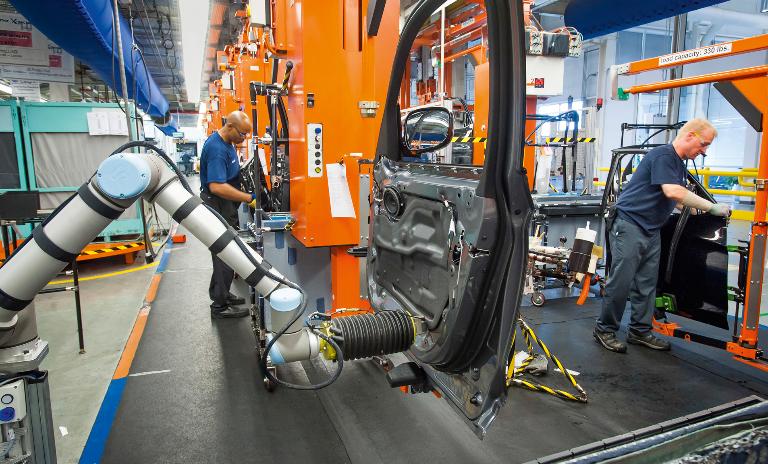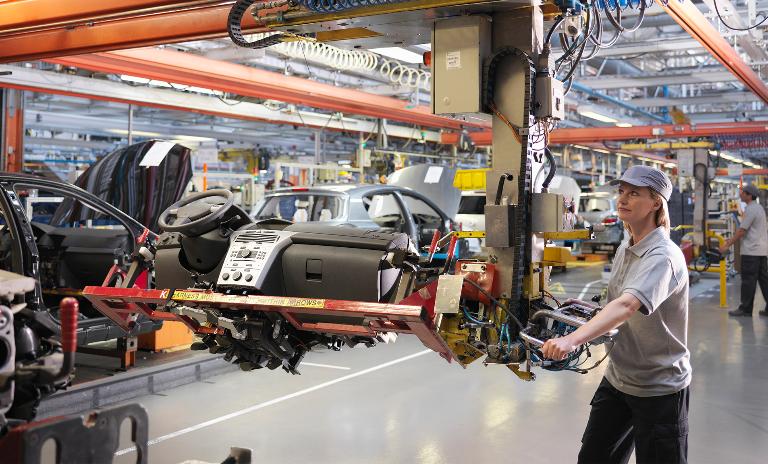cars a day are built by the BMW group.
" Industry 4.0 won’t replace people. Human beings will remain the pivotal success factor. "


HARALD KRÜGER: The BMW Group always puts people at the center of its production systems, and Industry 4.0 must support those people. That is absolutely fundamental. Industry 4.0 won’t replace people. It is different to past developments such as computer-integrated manufacturing, which conjured up visions of deserted factories devoid of all human agency. I am convinced that human beings, their skills and their competencies will remain the pivotal success factor. They will be flanked by Industry 4.0, which will improve the ergonomic aspects of certain things, make processes more robust and provide information that has not been available hitherto. So we are not talking about pure automation.
For me, it is not a revolution that involves some huge digital leap forward. It is not as if what is valid today suddenly no longer applies. But one thing will change significantly: BMW, like other companies, needs people with a keen interest in a knowledge of systems. We will learn to focus more on systems and to think along integrated lines. We will see the whole system, not just individual work and process steps.
"The majority of the value added in our chain is already in the hands of the suppliers."
Connecting the entire value stream from raw material to end product, to the finished automobile, harbors potential that has not yet been exploited. The BMW Group is a company whose innovation sets it apart again and again – through the use of carbon fibers in the electrically-powered i3 and i8, for example. If you want to drive innovation in products, you’ve also got to drive innovation in processes. Industry 4.0 promises to make us more innovative and perhaps faster, for example by reducing the number of tests involving hardware. We are already moving toward more digital modeling: in prototype construction, in product and process development. Time is a very important factor in the competitive context.
That is why we are interested in it. We began with small pilot projects like the one at our US plant in Spartanburg, South Carolina. The collaborative robots deployed there in door assembly help the human workers – precisely, quickly and as often as necessary. The movements of both people and robots have been optimized and harmonized to ensure there are no collisions. That is what I call intelligent networking. That is the production of the future: interaction between humans and machines. We also had research partners on board. Our people won’t be replaced, but the robots help make the process even more stable, thus providing even greater quality assurance. This ergonomic assistance makes the production system sustainable. We are also trialing similar elements in other settings. That is driving progress in efficiency and quality – thanks to connectedness. And this is the opportunity that Industry 4.0 has to offer: enhanced connectivity that improves the overall result.
We are an OEM, so we will always concentrate on vehicle assembly, on the car itself. But maybe we will move toward more preassembled modules that are supplied to us in connected digital processes. That goes as far as simulated assembly, in which we develop one part of digital door assembly while the supplier develops the other part. The whole development and production system can be simulated, even across international facilities. Working together with our suppliers, we can make things leaner, faster and more stable. This will further optimize the way we interact, but I don’t think it will lead directly to shifts in the make-up of the value chain.
The majority of the value added in our chain is already in the hands of the suppliers. Especially in the premium segment, car production only works if suppliers and OEMs collaborate seamlessly. There are obviously all kinds of chains and different kinds of suppliers. Some contribute an entire system, including development. They develop a door panel and do the testing, too. But there are also component manufacturers and parts suppliers. In the context of connected production, we will intensify our cooperation with system suppliers, because the early phase of product development is important. We want integration to take place as early as possible. That way, we can align interfaces so that parts can be optimized collaboratively for lean, fast production from an early stage. That is how connectedness will increase. Having said that, Industry 4.0 will not fundamentally change the importance of our suppliers. They are already very important.
We are conducting projects to connect software. In the BMW Group, we work with project teams and without too much organization. Our Industry 4.0 strategy targets three objectives: First, projects in research and predevelopment. The collaborative robots in Spartanburg originally came from the predevelopment phase of production. We are interested in new, lightweight construction, a different kind of automation, new combinations of materials, easier fastening, and simpler production concepts for shorter production lead times. Second, we refine and improve ideas in the routine setting of volume production. We are currently investigating how we can deploy these elements for future model series and products: building smart networks to tap quality, cost and one-time expenditure potential. Third, we work with elements of Industry 4.0 in relation to the planning of new product projects and new production structures.
Let me give you an example. We are currently expanding our international production network, including a new plant in Brazil and one in Mexico. The factory in Spartanburg is also being ramped up significantly. New production structures are emerging that will take the online simulation of lead times and processes to a higher level. At an earlier stage and more intensively, we are mapping aspects of traditional technical planning into a connected, digital planning base that involves the suppliers. If we build a paintshop, for example, we commission a large plant engineering firm to deliver the whole thing. For BMW, the OEM, the important aspects are the lead times, the cool-off times, the stability of the entire production chain. Assembly processes are another example. We will leverage the benefits of collaborative robots to make our vehicle assembly more productive in other locations, too.
If you look at the example of Spartanburg, it certainly does! The production workers are delighted. Right now, we are evaluating the potential, we are learning. Industry 4.0 is all about ongoing development and improvement. It is early days, but the initial signs look very positive.
Efficiency and productivity are always important to me. Point number one: This robot technology is very reliable. I am not at all delighted when production gets disrupted. We produce a new car every 60 seconds, so every second of downtime is a loss to us. Point number two: Everything can be implemented and integrated much more quickly. We need fewer big superstructures, no safety bars and no cages. Our new robots are small and flexible. It takes less time to integrate and switch them, so they can even be deployed more quickly in new production settings. There are several aspects of this technology that I get excited about.
I don’t think there will be a “digital leap” of 20 to 30% in productivity. But I am happy about small, day-to-day productivity gains. Just 5% would be a lot if you map that onto two million vehicles a year. We build about 8,000 cars a day, so our responsibility is to be efficient day in, day out.


